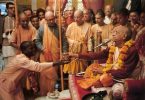Question: How to understand the following statement of Chapter 17 of Nectar of Devotion? Our standard understanding is that Sukadeva Goswami was immersed in the brahman conception, while still in the womb. Corresponding verses from Bhakti Rasamrita Sindu are also copied.
As far as heartfelt wishes are concerned, there is a statement in the Çuka-saàhitä where Närada tells Çréla Vyäsadeva, “You have a son who is the greatest devotee of the Personality of Godhead, and I can observe that without any following of the regulative principles of devotional service, he is already enriched with many of the symptoms achieved by the execution of devotional service after many, many births.”
~~~
BRS || 1.3.19 ||
härdaù—prasäda äntaro yaù syät sa härda iti kathyate ||19||
Translation: The definition of härda is given:
That mercy which arises from within is called härda.
BRS || 1.3.20 ||
yathä çuka-saàhitäyäà—
mahäbhägavato jätaù putras te bädaräyaëa |
vinopäyair upeyäbhüd viñëu-bhaktir ihoditä ||20||
Translation: Thus, it is said in the Çuka-saàhitä:
“O Bädaräyaëa, You have given birth to a great devotee as your son. Without sädhana, which brings about the goal, bhakti to Viñëu has appeared within his heart.”
Jéva Gosvämé’s Commentary
Bhakti to Viñëu, which is the goal (upeya), has appeared without sädhana (upäyaiù). The conclusion is that he attained bhäva only by the mercy of the Lord, since there is no evidence of performance of any sädhana, or of obtaining the mercy of devotees. This mercy must have appeared through the heart, because he developed bhakti in the form of remembering the Lord while still in the womb. While in the womb, he did not see the Lord or receive words of blessing from the Lord. Thus, mercy manifesting in the heart could have been the only way. The Brahma-vaivarta Puräëa gives the details.
Answer by Romapada Swami:
Commentators on Bhakti-rasamrita-sindhu 1.3.20 say that bhakti in the form of smarana was present in Srila Sukadeva Goswami in the womb.
The logical explanation here is that bhakti was present in the form of a seed, or santa-rati, but was covered by impersonal knowledge, due to such knowledge being prominent in him. This knowledge became even more prominent when he came out of the womb. Later, bhakti to the Lord was rekindled and perfected by studying Srimad Bhagavatam under the guidance of Vyasadeva.
“Salvationists” can attain santa-rati.
“Rati” means “bhava“. The two terms are interchangeable.
Santa-rati is what impersonalists are recipients of, if they are not mayavadis.
They experience some “preliminary stage of bliss” (which is the equivalent to our terminology of bhava, or santa-rati), in the form of appreciation for Brahman. This rati, characterized by complete vairagya, is directed at the impersonal feature.
Later, Sukadeva had his santa-rati elevated, by the grace of Srimad-Bhagavatam and Vyasadeva.







